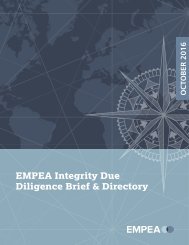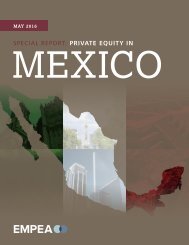Create successful ePaper yourself
Turn your PDF publications into a flip-book with our unique Google optimized e-Paper software.
African Onshore Financial Centres<br />
REPORT<br />
January 2015<br />
EXECUTIVE SUMMARY<br />
Financial service providers tend to cluster in centres.<br />
These centres generally develop for commercial reasons.<br />
Thus over time they become the main centres <strong>of</strong> financial<br />
services, <strong>of</strong> international trade and they become the key<br />
components in international commerce. It is certainly<br />
possible to delineate reasons why some financial centres<br />
have developed and why some have grown to be the largest<br />
centres but it is more difficult to create a definitive blueprint<br />
for how to develop a new financial centre from scratch.<br />
This poses a challenge for policymakers in developing<br />
countries that may be seeking to develop a specific financial<br />
centre as one <strong>of</strong> the pillars <strong>of</strong> their strategy for development<br />
and promoting growth. Clearly there is evidence to show<br />
that growing economies will attract providers <strong>of</strong> financial<br />
services. Normally, the development <strong>of</strong> a financial centre<br />
in any particular country goes hand in hand with broader<br />
development within the economy—i.e., large and growing<br />
economies develop financial markets as is demonstrated in<br />
Africa by South Africa, Nigeria and Kenya. There are only<br />
a few cases where creating a financial centre is itself the<br />
catalyst for significant growth and development; the best<br />
recent example <strong>of</strong> this is possibly Dubai.<br />
It is important to recognise that there are different types<br />
<strong>of</strong> financial centres in today’s world. They have developed<br />
for different reasons, they are <strong>of</strong> different sizes and <strong>of</strong>ten<br />
specialise in different activities. The largest and most<br />
influential centres are Global Centres such as London and<br />
New York; they provide the most sophisticated services at<br />
a global scale and host the largest collection <strong>of</strong> financial<br />
services providers. Next are the regional centres such as<br />
Hong Kong or Dubai that provide sophisticated financial<br />
services to their particular geography. Their growth in recent<br />
years has benefitted significantly from accelerated regional<br />
development. Finally, there are the administrative centres<br />
such as Mauritius or the Cayman Islands that provide certain<br />
administrative services for a broad cross section <strong>of</strong> clients.<br />
A classification <strong>of</strong> these financial sectors into ‘onshore<br />
centres’ and ‘<strong>of</strong>fshore centres’ is slightly more complex.<br />
In general the administrative centres are more likely<br />
to be classified as ‘<strong>of</strong>fshore centres.’ They <strong>of</strong>ten act as<br />
jurisdictions for booking transactions or for locating certain<br />
financial vehicles such as funds. This is usually because <strong>of</strong><br />
the favourable tax environment they provide for users <strong>of</strong> that<br />
particular centre. Administrative centres can also be seen<br />
as the link between sources <strong>of</strong> capital and users <strong>of</strong> capital—<br />
the reason why they are mostly ‘<strong>of</strong>fshore’ is that they do not<br />
introduce additional taxation on top <strong>of</strong> taxes levied on users<br />
<strong>of</strong> capital (investees) and providers <strong>of</strong> capital (investors).<br />
It is difficult to envisage building a new full service global<br />
financial centre from the bottom up without accompanying<br />
growth and development in that economy. In addition the<br />
host government needs to create policies which make<br />
their centre more attractive than possible competitors<br />
and makes the centre user friendly for international<br />
capital markets.<br />
Thus, when policymakers consider building new African<br />
onshore centres, they need to consider first whether it<br />
is to be a regional or administrative centre. Some <strong>of</strong> the<br />
conditions needed to establish either <strong>of</strong> these are similar<br />
but some are definitely unique. Understanding these can<br />
help them understand which measures may be needed in<br />
order to succeed with their goals <strong>of</strong> building new onshore<br />
centres.<br />
102 |





